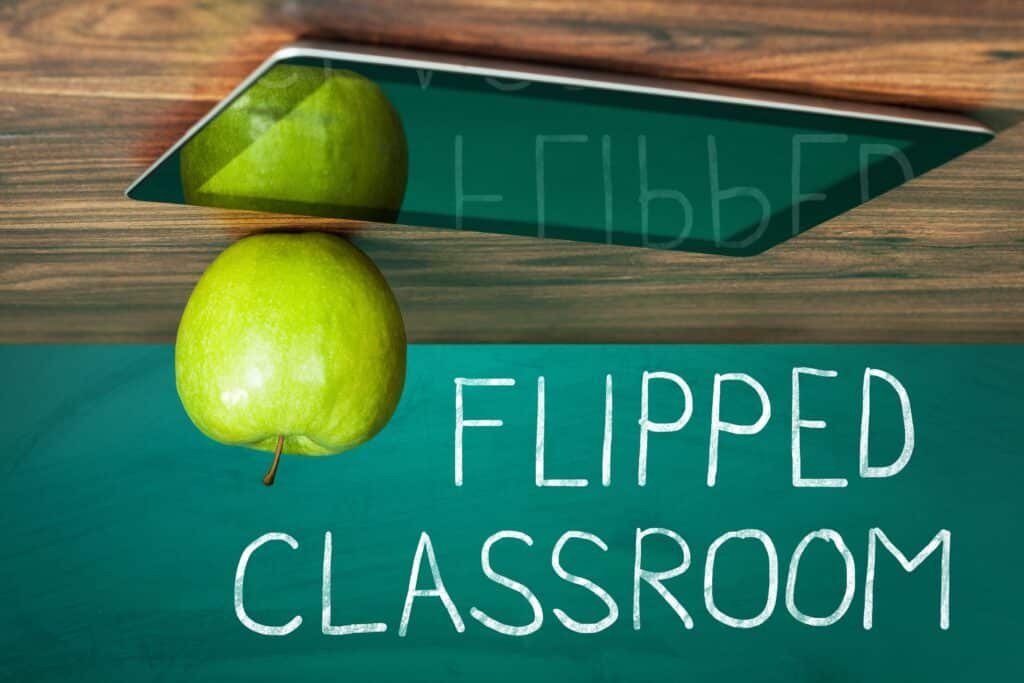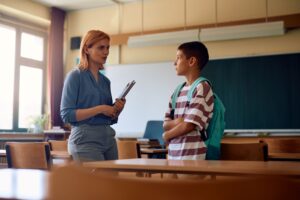As distance learning became the new norm during the pandemic, teachers had to get creative and think outside the box in order to reach students and keep them engaged during this challenging time. As the saying goes, necessity is the mother of invention. As we have returned to in-person learning, some of these new perspectives have led to newly shaped ideas about how our students learn best. One of the big ideas we’ve heard over the last couple of years is “active learning,” and one method of active learning is the flipped classroom.
What is a Flipped Classroom?
A flipped classroom is one in which the traditional sequencing of lesson presentation is flipped, making better use of the class time we have with our students.
In a traditional classroom, teachers use class time for lectures or direct instruction to present new material. Then, students spend time at home practicing or reviewing that information alone. The old model of students sitting quietly and working independently is not always the best option. Think about it…students can do that at home! Why use valuable class time for something that requires no interaction? Use it to promote deeper learning.
In the flipped classroom, students are exposed to the new material before class time, often in the form of video lessons. Then, in class students can be actively engaged in discussion or activities with other students during which the teacher can facilitate, monitor progress, and check for understanding within student learning.
While video lectures have become common in the flipped classroom format, there are other activities that students can participate in at home prior to their class time to prepare. Some of these include:
- Reviewing online course material
- Participating in online discussion
- Performing research
- Reading digital or physical texts
After students have spent time before class in their preparation activities, they are then prepared for classroom activities, such as:
- Skill practice guided and/or monitored by the teacher
- Face-to-face discussions with peers
- Debate
- Presentations
- Center learning
- Lab experiments
- Peer assessments
What are the Benefits of a Flipped Classroom?
Efficiency
By allowing students to watch, listen to, or read the lecture/direct instruction before class time, teachers are able to facilitate activities during class time, in which they can then monitor students’ understanding, making much better use of time.
Flexibility
As listed above, there are many different ways to implement the flipped classroom. You have a great deal of flexibility in the types of activities students can participate in before and during class.
High-Level Learning
I’m sure you’ve heard: “The one doing the talking is the one doing the learning.” A group of U.K. researchers did a cumulative study of over 70 different studies including over 7000 students regarding the importance of on-task talking and its importance in learning. In these studies, the researchers found that consistently, the more students participated in discussions with peers the better they performed. Furthermore, they found that students were even more likely to perform at a higher level when the discussion was with an adult. This is a far higher level of learning than listening to a lecture and doing homework.
Homework
I know this can be a highly debated topic, but the research on homework shows that it doesn’t always work. Students can get stuck and frustrated working on their own. Sometimes, parental support may confuse students because of new or changing methods they may not be aware of. In the flipped classroom, the only homework students are doing is their preparation activities.
Varying Grade-Levels
Of course, we can see how easily adaptable this method is in high school, middle school, and even upper elementary. In primary grades however, it may be a little more tricky, but definitely can be done. Giving parents some direct-instruction tips on a phonics or math skill to do for “homework” the night before, will allow you to do a discussion or group activity the following day without time spent on direct-instruction.
Flipped Classroom Challenges to Be Aware Of
As with any new approach that seems to be the best of all worlds, there are without a doubt some challenges that one must be aware of.
Lack of Preparation
Students are always more or less motivated to do any outside work to prepare for class. Find ways to keep students accountable for that pre-class preparation and reward those that are prepared.
It may require the teacher to get creative in encouraging particularly withdrawn or shy students to be more involved. This could be as simple as putting this type of student in with a group of especially compassionate and understanding students rather than more competitive and outspoken students.
Also, if the teacher stays with a group that struggles with participation, they can facilitate discussion by prompting and asking questions to promote flipped classroom motivation and engagement.
Limited Access
As you may have noticed, many of the activities that students would participate in before class at home are dependent on access to technology such as computers and internet access. For students in some areas, this may be an issue. If students do not have this kind of access and the school or district cannot provide that access, this would be a serious hindrance to this learning method.
As with any method of instruction, there are pros and cons. Just remember, it doesn’t have to be all or nothing. Try incorporating some of these flipped classroom ideas into your classroom.
However you look at it and choose to use it, there’s no doubt that the flipped classroom method helps you to maximize your limited classroom time in order to make the most out of your time with your students.
Teachers never stop learning; check out our available graduate degree programs to hone your skills and promote lifelong learning and academic excellence.




